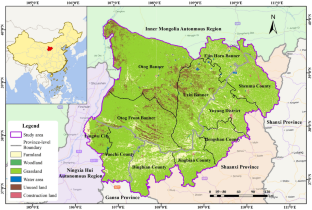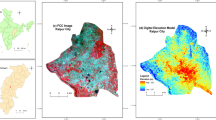Abstract
Studying the vegetation dynamics and driving mechanisms in ecologically fragile areas is crucial for understanding the process of ecosystem evolution and achieving sustainable development. This study focused on the entire Mu Us Sandy Land (MUSL) and utilized the variation coefficient, trend analysis, and Hurst index to investigate the spatio-temporal variation in fractional vegetation cover (FVC) and its sustainability characteristic from 2000 to 2020. Meanwhile, residual analysis was employed to separate the impact of climatic factors such as temperature and precipitation, as well as anthropogenic factors, on FVC change. The results showed that FVC of MUSL was lower in the northwest and higher in the southeast. Over the past 21 years, the average annual FVC value increased from a low of 0.3486 in 2000 to a high of 0.6186 in 2018, with a growth rate of 0.0996/10a. Overall, the vegetation condition of MUSL has improved, with about 70.10% of the region having a significant increase in FVC, mainly concentrated in the southeast, while FVC decrease mainly occurred in the northwest. However, the majority of these FVC changes exhibited an anti-persistence characteristic, indicating that future FVC growth in many regions was fraught with uncertainty. Human activities accounted for 70.71% of FVC change, while climate factors contributed only 29.29%, indicating that the former dominated this ecological process. In this arid and fragile area, precipitation had a greater impact on FVC than temperature. This study illustrates the dominant role of ecological engineering in vegetation greening in MUSL, while also pointing out the unsustainable risk of the restoration mode, which provides a theoretical basis for adjusting and optimizing future management strategies.








Similar content being viewed by others
Data availability
The data behind this article will be shared with the appropriate authors upon reasonable request.
References
Cai, D., Ge, Q., Wang, X., et al. (2020). Contributions of ecological programs to vegetation restoration in arid and semiarid china. Environmental Research Letters, 15(11), 114046.
Evans, J., & Geerken, R. (2004). Discrimination between climate and human-induced dryland degradation. Journal of Arid Environment, 57(4), 535–554.
Feng, X., Sun, G., Fu, B., et al. (2012). Regional effects of vegetation restoration on water yield across the Loess Plateau, China. Hydrology and Earth System Sciences, 16, 2617–2628.
Fu, H., Wang, R., & Wang, X. (2022). Analysis of spatiotemporal variations and driving forces of NDVI in the yellow river basin during 1999–2018. Research of Soil and Water Conservation, 29(2), 1–10. (in Chinese).
Guo, Z., Liu, S., Kang, W., et al. (2018). Change trend of vegetation coverage in the Mu Us Sandy region from 2000 to 2015. Journal of Desert Research, 38(05), 1099–1107. (in Chinese).
Guo, Z., Wang, T., Liu, S., et al. (2021). Biomass and vegetation coverage survey in the Mu Us sandy land—Based on unmanned aerial vehicle RGB images. International Journal of Applied Earth Observations and Geoinformation, 94, 102239.
Guo, Z., Wei, W., Shi, P., et al. (2020). Spatiotemporal changes of land desertification sensitivity in the arid region of Northwest China. Acta Geographica Sinica., 75(9), 1948–1965. (in Chinese).
He, T. (2008). The environment changes of Mu Us Desert in historical period. Lanzhou University, (in Chinese)
Jiang, W., Yuan, L., Wang, W., et al. (2015). Spatio-temporal analysis of vegetation variation in the Yellow River Basin. Ecological Indicators, 51, 117–126.
Jin, K., Wang, F., Hang, J., et al. (2020). Contribution of climatic change and human activities to vegetation NDVI change over China during 1982–2015. Acta Geographica Sinica, 75(05), 961–974. (in Chinese).
Kang, Y., Guo, E., Wang, Y., et al. (2021). Monitoring vegetation change and its potential drivers in inner Mongolia from 2000 to 2019. Remote Sensing, 13(17), 3357.
Li, G., Zhou, Y., Fan, J., et al. (2019). Spatiotemporal pattern and sustainability analysis of extreme temperature indices on the Tibetan Plateau. Geomatics & Spatial Information Technology, 42(12), 51–54. (in Chinese).
Li, J., Wang, J., Zhang, J., et al. (2021). Dynamic changes of vegetation coverage in China-Myanmar economic corridor over the past 20 years. International Journal of Applied Earth Observation and Geoinformation, 102, 102378.
Li, M., Han, Y., Zhao, H., et al. (2022). Analysis on spatial-temporal variation characteristics and driving factors of fractional vegetation cover in Ningxia based on geographical detector. Ecology and Environment Sciences, 31(7), 1317–1325. (in Chinese).
Li, Y., Cao, Z., Long, H., et al. (2017). Dynamic analysis of ecological environment combined with land cover and NDVI changes and implications for sustainable urban–rural development: The case of Mu Us Sandy Land, China. Journal of Cleaner Production, 142, 697–715.
Lian, X., Jiao, L., Liu, Z., et al. (2022). Multi-spatiotemporal heterogeneous legacy effects of climate on terrestrial vegetation dynamics in China. Giscience & Remote Sensing, 59(1), 164–183.
Liu, J., Liu, H., Zhuo, Y., et al. (2017). Dynamics and driving forces of landscape patterns in Mu Us Sandy Land, from 1990 to 2014. Pratacultural Science, 34(02), 255–263. (in Chinese).
Liu, Y., Liu, Y., Cheng, C., et al. (2022). Spatio-temporal changes and influencing factors of vegetation coverage in Yulin City During the Past 20 years since the implementation of the “grain for green” program. Journal of Soil and Water Conservation, 002, 36. (in Chinese).
Ma, X., Lin, F., Yuan, L., et al. (2023). Vegetation coverage change and its response to ecological protection project in Fenhe River Basin. Journal of Desert Research, 43(3), 85–94. (in Chinese).
Meng, N., Wang, N., Cheng, H., et al. (2023). Impacts of climate change and anthropogenic activities on the normalized difference vegetation index of desertified areas in northern China. Journal of Geographical Sciences, 33(3), 483–507.
NFG-NP (The National Forestry and Grassland Administration and the National Park Administration). The results of the sixth round survey on desertification and sandification in china and the fourth rocky desertification survey in karst areas were released-the "Double reversal" of desertification and sandification in all the investigated provinces was realized for the first time in China. [2023–01–04]. http://www.forestry.gov.cn/main/135/20230109/154423802716439.html
Pei, H., Liu, M., Jia, Y., et al. (2021). The trend of vegetation greening and its drivers in the Agro-pastoral ecotone of northern China, 2000–2020. Ecological Indicators, 129, 108004.
Peng, S., Ding, Y., Liu, W., et al. (2019). 1 km monthly temperature and precipitation dataset for China from 1901 to 2017. Earth System Science Data, 11(4), 1931–1946.
Qu, Y., Zhao, Y., Ding, G., et al. (2021). Effects of climate and human activities on vegetation cover changes in Xilingol steppe. Arid Zone Research, 38(3), 802–811. (in Chinese).
Shen, G. (2017). Analysis on climatic factors and desertification evolution trend in the southeast of Mu Us sandland. Northwest University. (in Chinese)
Shen, B., Wei, Y., Ma, L., et al. (2022). Spatiotemporal changes and drivers of fractional vegetation cover in Inner Mongolia grassland of China. Transations of the Chinese Society of Agricultural Engineering, 38(12), 118–126. (in Chinese).
Song, W., Feng, Y., & Wang, Z. (2022). Ecological restoration programs dominate vegetation greening in China. Science of the Total Environment, 848, 157729.
Sun, Z., Mao, Z., Yang, L., et al. (2021). Impacts of climate change and afforestation on vegetation dynamic in the Mu Us Desert, China. Ecological Indicators, 129, 108020.
Wang, J., & Zhang, F. (2020). Spatial-temporal pattern and gravity center change of fractional vegetation cover in Xinjiang, China from 2000 to 2019. Transactions of the Chinese Society of Agricultural Engineering, 36(20), 188–194. (in Chinese).
Wang, X., Song, J., Xiao, Z., et al. (2022a). Desertification in the Mu Us Sandy Land in China: Response to climate change and human activity from 2000 to 2020. Geography and Sustainability, 3, 177–189.
Wang, Z., Zhang, T., Pei, C., et al. (2022b). Multisource remote sensing monitoring and analysis of the driving forces of vegetation restoration in the Mu Us Sandy Land. Land., 11(9), 1553.
Wessels, K., Prince, S., Malherbe, J., et al. (2007). Can human-induced land degradation be distinguished from the effects of rainfall variability? A case study in South Africa. Journal of Arid Environment, 68(2), 271–297.
Yan C, Wang J. 1:100000 desert (sand) distribution data set in China. National cryosphere desert data center (http://www.ncdc.ac.cn), 2019, https://cstr.cn/CSTR:11738.11.ncdc.Westdc.2020.676.
Yan, E., Lin, H., Dang, Y., et al. (2014). The spatiotemporal changes of vegetation cover in Beijing-Tianjin sandstorm source control region during 2000–2012. Acta Ecologica Sinica, 34(17), 5007–5020. (in Chinese).
Yan, F., & Wu, B. (2013). Desertification progress in Mu Us Sandy Land over the past 40 years. Arid Land Geography, 36(06), 987–996. (in Chinese).
Yang, J., & Huang, X. (2021). The 30 m annual land cover dataset and its dynamics in China from 1990 to 2019. Earth System Science Data, 13(8), 3907–3925.
Yin, Z., Feng, Q., Wang, L., et al. (2022). Vegetation coverage change and its influencing factors across the northwest region of China during 2000–2019. Journal of Desert Research, 42(4), 11–21. (in Chinese).
Yuan, L., Jiang, W., Shen, W., et al. (2013). The spatio-temporal variations of vegetation cover in the Yellow River Basin from 2000 to 2010. Acta Ecologica Sinica, 33(24), 7798–7806. (in Chinese).
Zhang X. (2021) Characteristics and evaluation of Gangue Mountain Plantation in Lingwu Mining Area of Ningxia. Inner Mongolia Agricultural University, (in Chinese)
Zhang, H., Zhan, C., Xia, J., et al. (2022). Spatio-temporal variations and strip patterns of vegetation in the Inner Mongolia of Yellow River Basin. Acta Ecologica Sinica, 42(21), 8818–8829. (in Chinese).
Zhang, M., Wang, K., Liu, H., et al. (2023). Vegetation inter-annual variation responses to climate variation in different geomorphic zones of the Yangtze River Basin, China. Ecological Indicators, 152, 110357.
Zhang, M., & Wu, X. (2020). The rebound effects of recent vegetation restoration projects in Mu Us Sandy land of China. Ecological Indicators, 113, 106228.
Zhao S, Wang Y, Qiao X. (2023b) Spatiotemporal variation and driving factors for FVC in Huaihe River basin from 1987 to 2021. Transactions of the Chinese society for agricultural machinery: 1–18 [2023b-05–29]. http://kns.cnki.net/kcms/detail/11.1964.s.20230221.1426.016.html (in Chinese)
Zhao, A., Zhang, A., Liu, H., et al. (2017). Spatiotemporal variation of vegetation coverage before and after implementation of grain for green project in the loess plateau. Journal of Natural Resources, 32(3), 449–460.
Zhao, M., Geruo, A., Zhang, J., et al. (2021a). Ecological restoration impact on total terrestrial water storage. Nature Sustainability, 4(1), 56–62.
Zhao, N., Zhao, Y., Zou, H., et al. (2023a). Spatial and temporal trends and drivers of fractional vegetation cover in Heilongjiang Province, China during 1990–2020. Chinese Journal of Applied Ecology, 34(5), 1320–1330. (in Chinese).
Zhao, Y., Feng, Q., & Lu, A. (2021b). Spatiotemporal variation in vegetation coverage and its driving factors in the Guanzhong Basin, NW China. Ecological Informatics, 64, 101371.
Zheng, Y., Dong, L., Xia, Q., et al. (2020). Effects of revegetation on climate in the Mu Us Sandy Land of China. Science of the Total Environment, 739, 39958.
Zhou, Y., Yang, X., Jin, Y., et al. (2020). Classification of the desertification control models in north China. Journal of Desert Research, 40(3), 106–114. (in Chinese).
Zhu F. (2015) The influence of climate change over the temporal and spatial variation of desertification of four main dune fields over the past 30 years in northern China. Nanjing University, (in Chinese)
Acknowledgements
This research was supported by the Fundamental Research Funds for the Central Universities [2452018143].
Author information
Authors and Affiliations
Corresponding author
Additional information
Publisher's Note
Springer Nature remains neutral with regard to jurisdictional claims in published maps and institutional affiliations.
Supplementary Information
Below is the link to the electronic supplementary material.
Rights and permissions
Springer Nature or its licensor (e.g. a society or other partner) holds exclusive rights to this article under a publishing agreement with the author(s) or other rightsholder(s); author self-archiving of the accepted manuscript version of this article is solely governed by the terms of such publishing agreement and applicable law.
About this article
Cite this article
Lin, J., Bo, W., Dong, X. et al. Evolution of vegetation cover and impacts of climate change and human activities in arid regions of Northwest China: a Mu Us Sandy Land case. Environ Dev Sustain (2024). https://doi.org/10.1007/s10668-024-04704-4
Received:
Accepted:
Published:
DOI: https://doi.org/10.1007/s10668-024-04704-4




